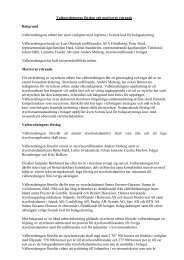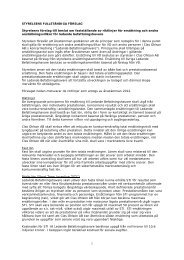Annual Report 2012/13 - Clas Ohlson
Annual Report 2012/13 - Clas Ohlson
Annual Report 2012/13 - Clas Ohlson
Create successful ePaper yourself
Turn your PDF publications into a flip-book with our unique Google optimized e-Paper software.
Note 1 cont.<br />
In defined-benefit plans, payments are made to employees and former<br />
employees based on final salary and the number of years of service. The<br />
Group bears the risk associated with the pledged payments being made.<br />
The net sum of the estimated value of obligations and fair value of plan assets<br />
is recognised on the balance sheet as either a provision or a noncurrent<br />
financial receivable. In cases where a surplus in a plan cannot be fully utilised,<br />
only that part of the surplus that the company can recover through reduced<br />
future contributions or repayments is recognised.<br />
Regarding defined-benefit plans, the pension expense and pension<br />
obligation are calculated according to the so-called Projected Unit Credit<br />
Method. Under this method, the expense is distributed as the employees<br />
perform services for the company that increase their entitlement to future<br />
remuneration. The calculation is performed annually by independent<br />
actuaries. The company’s commitments are measured at the current value<br />
of expected future payments using a discount rate which is equivalent to the<br />
interest on municipal bonds (pertaining to Norway) with a term equivalent to<br />
the current commitments. The principal actuarial assumptions are stated in<br />
Note 19.<br />
Actuarial gains and losses may arise in establishing the present value of<br />
the obligation and the fair value of plan assets. These arise either through<br />
the fair value deviating from the assumption made previously, or through<br />
a change in assumptions. The part of the cumulative actuarial gains and<br />
losses, at the end of the preceding year, exceeding 10 per cent of the greater<br />
of the present value of the obligations and the fair value of the plan assets is<br />
recognised in profit or loss over the average remaining period of service of<br />
employees.<br />
Furthermore, long-term incentive programmes (LTI) that entitle employees<br />
to acquire shares and require the approval of the <strong>Annual</strong> General Meeting<br />
(AGM). LTI 2010, LTI 2011 and LTI <strong>2012</strong> are recognised in accordance with<br />
IFRS 2 Share-based Payment. The Group posts a provision for anticipated<br />
social security contributions that will be paid when the shares are allotted and<br />
when the options are exercised. The provision for social security contributions<br />
is reassessed every balance-sheet date based on the fair value.<br />
Provisions<br />
Provisions are recognised in the balance sheet among current and noncurrent<br />
liabilities when the Group has a legal or informal obligation resulting from an<br />
event that has occurred and it is likely that an outflow of resources will be<br />
required to discharge the commitment and a reliable estimate can be made<br />
of the amount. Provisions are made for open purchase, unredeemed gift<br />
cards and estimated future guarantee commitments, as well as bonus points<br />
to customer club members.<br />
Accounts payable<br />
Accounts payable are initially recognised at fair value and thereafter at<br />
amortised cost applying the effective interest method.<br />
Borrowing<br />
Borrowing is initially recognised at fair value, net after transaction expenses.<br />
Borrowing is thereafter recognised at amortised cost and any difference<br />
between the amount received (net after transaction costs) and the repayment<br />
amount is recognised in profit or loss distributed over the borrowing period,<br />
applying the effective interest method.<br />
Charges paid for credit facilities are recognised as transaction costs for<br />
borrowing insofar as it is probable that the credit will be utilised in full or<br />
in part. In such cases, charges are recognised when the credit has been<br />
utilised. When there is no evidence that the credit will be utilised in full or<br />
in part, the charges will be recognised as advance payment for financial<br />
services and distributed over the term of current credit facilities.<br />
Borrowing is classified as current liabilities if the Group is not<br />
unconditionally entitled to postpone payment of the debt for at least 12<br />
months after the balance-sheet date.<br />
Cash-flow statement<br />
The cash-flow statement is prepared according to the indirect method.<br />
The recognised cash flow comprises only transactions that entail receipts<br />
or disbursements. In addition to cash or bank balances, current financial<br />
investments that are subject only to an insignificant risk of fluctuation in<br />
value and have a remaining term of less than three months from the time of<br />
acquisition are classified as cash and cash equivalents.<br />
Segment accounting<br />
<strong>Clas</strong> <strong>Ohlson</strong> has the following segments: Sweden, Norway, other<br />
segments (Finland and the UK) as well as Group-wide. The Group-wide<br />
segment pertains to the Group-wide functions in Sweden that assist sales<br />
organisations with purchasing, distribution, marketing, management and<br />
other support. A large portion of the Group’s value is generated in the<br />
Group-wide segment. The Group’s internal pricing was adapted to these<br />
prerequisites.<br />
Parent Company accounting policies<br />
The Parent Company has prepared its annual accounts in accordance with<br />
the Swedish <strong>Annual</strong> Accounts Act and Recommendation RFR 2 Accounting<br />
for Legal Entities, of the Swedish Financial Accounting Standards Council.<br />
This means that the Parent Company, in the annual accounts of the legal<br />
entity, has to apply all EU-approved IFRS standards and interpretations as far<br />
as possible under the terms of the <strong>Annual</strong> Accounts Act and in consideration<br />
of the connection between accounting and taxation. The recommendation<br />
specifies the exceptions from and additions to IFRS that are to be made. At<br />
<strong>Clas</strong> <strong>Ohlson</strong>, the difference between the consolidated and Parent Company<br />
accounting policies is that IAS 1 is not applied with regard to preparation of<br />
the balance sheets and income statements for the Parent Company, which<br />
instead are prepared in accordance with the <strong>Annual</strong> Accounts Act. The<br />
regulations in IAS 39 pertaining to financial guarantee agreements are not<br />
applied with respect to guarantee agreements for subsidiaries. In the Parent<br />
Company, loan expenses are charged against profits for the period to which<br />
they refer. Shares in the subsidiaries are recognised at cost less deductions<br />
for any impairment.<br />
The accounting policies for the Parent Company have been consistently<br />
applied to all periods presented in the Parent Company’s financial statements.<br />
Note 2<br />
Financial risks<br />
The Group is exposed to a variety of financial risks through its operations:<br />
market risk (including currency risk, interest-rate risk and price risk), credit<br />
risk, liquidity risk and cash-flow risk. The Group’s overall risk management<br />
policy focuses on the unpredictability of financial markets and endeavours to<br />
minimise potential unfavourable effects on the Group’s financial results. The<br />
Group uses derivatives to hedge certain risk exposure.<br />
The Board is responsible for the overall risk effort for the Group. At <strong>Clas</strong><br />
<strong>Ohlson</strong>, the Group’s risk situation is updated and analysed regularly. This is<br />
done through a systematic process in which risks are identified, evaluated<br />
and assessed, managed, monitored and reported. In a collective assessment<br />
of possible impact and probability, priority is placed on the risks deemed to<br />
have the most negative impact. For more information, refer to page 54 of the<br />
annual report.<br />
MARKET RISK<br />
Currency risk<br />
A significant portion of accounts payable comprises liabilities in foreign<br />
currencies and is therefore subject to currency risks. In the Group, the<br />
principal currencies used in purchases are hedged in order to reduce any<br />
currency risks, in accordance with the financial policy. Approximately 50 per<br />
cent of the anticipated flow six months ahead is hedged when prices in the<br />
product range are set.<br />
Approximately 45 per cent of the company’s purchases are made in<br />
currencies other than Swedish kronor (SEK). The principal currencies for<br />
purchasing are the US dollar (USD), Hong Kong dollar (HKD) and euro (EUR).<br />
In addition, movements of SEK against the Norwegian krone (NOK) are very<br />
significant to the Group, because more than 40 per cent of sales take place<br />
in Norway. Net exposure to EUR is low, because the company has higher<br />
EUR-denominated sales due to its expansion in the Finnish market. The table<br />
below shows how profit is affected by changes in the principal currencies<br />
(excluding hedging).<br />
Impact on profit<br />
Currency Change before tax, SEK M<br />
NOK +/– 5 per cent +/– 59<br />
USD +/– 5 per cent –/+ 50<br />
HKD +/– 5 per cent –/+ 7<br />
EUR +/– 5 per cent –/+ 1<br />
GBP +/– 5 per cent –/+ 7<br />
Cash and cash equivalents are also exposed to currency risk since a certain<br />
proportion of the funds is invested in foreign currencies.<br />
Refinancing and liquidity risk<br />
Refinancing and liquidity risk pertains to the risk that <strong>Clas</strong> <strong>Ohlson</strong> is unable<br />
to receive existing loans or meet payment obligations due to insufficient<br />
liquidity. Refinancing requirements are regularly reviewed by <strong>Clas</strong> <strong>Ohlson</strong>’s<br />
central finance function, which is responsible for external borrowing. Refinancing<br />
requirements are primarily contingent on market trends and investment<br />
plans.<br />
Interest-rate risk<br />
The interest-rate risk is low since the company’s interest expenses are low in<br />
relation to total earnings.<br />
66<br />
Accounts














